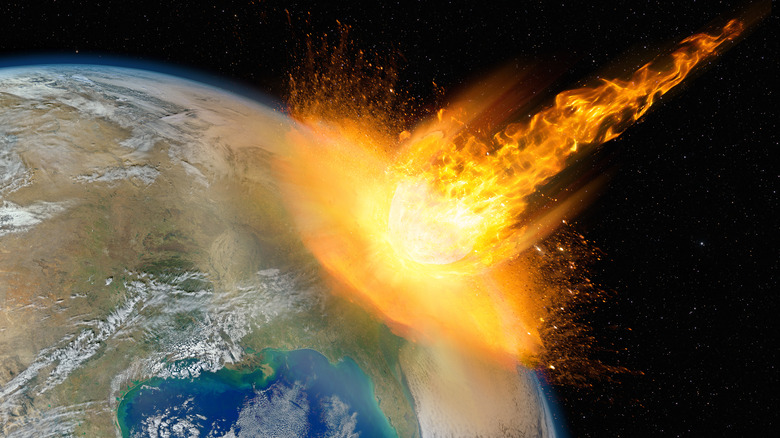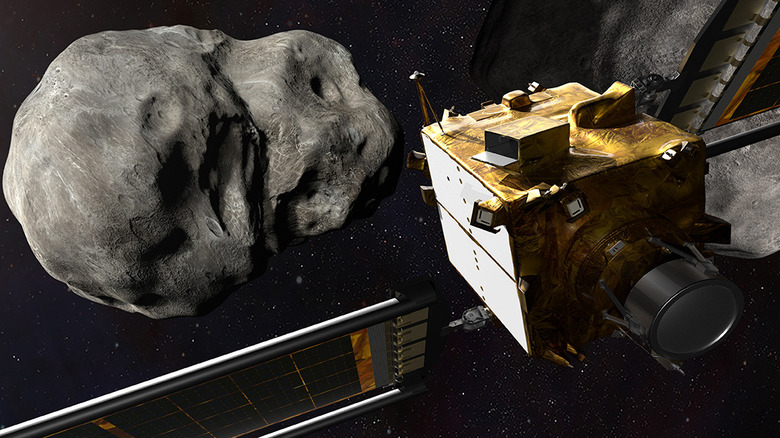The Unexpected Way We Might Prevent An Asteroid From Hitting Earth
One of the favorite themes of disaster movies is imagining the result of an asteroid (made from rocky materials and metals) or a comet (made from rocky materials, dust, and ice) on course for Earth and potentially wiping out life as is believed to have happened to the dinosaurs. It's widely accepted that dinosaurs were made extinct when an asteroid about 6 to 9 miles wide collided with the Earth, leaving a massive crater about 93 miles wide and 12 miles deep. This event occurred at least 66 million years ago, which, thankfully for our existence, not only allowed humankind to propagate but also shows that these extinction-level events (ELEs) are not especially common.
While the chances of something similar happening to Earth again anytime soon are relatively low, NASA scientists, among others, are reassuringly keeping an eye on things for us regardless. The Center for Near Earth Object Studies (CNEOS), which is located at NASA's Jet Propulsion Laboratory (JPL) in California, has been undertaking a comprehensive analysis of the probabilities of Near-Earth Objects (NEOs), which are asteroids and comets that could have close encounters with Earth over the next century. CNEOS reports to the impressively named NASA Planetary Defense Coordination Office (PDCO) located in Washington, D.C. PDCO focuses its efforts on developing strategies and technologies for countering asteroids or comets identified as potentially hazardous objects (PHOs), which includes some methods you might think would only happen in a Hollywood blockbuster.
Deflection or nukes
According to planetary scientist Detlef Koschny, we have mapped 90% of asteroids that are 1 kilometer in size or larger, with scientists confident that none of these poses a threat to Earth anytime in the next 100 years (via Earthsky.org). However, should an asteroid smaller than 1 kilometer threaten Earth over this time, scientists have been hard at work developing strategies to counter any such threat. NASA is partnering with the Johns Hopkins Applied Physics Laboratory (APL) on a mission called the Double Asteroid Redirection Test (DART), which will attempt to redirect an asteroid this September. The spacecraft will smash into an asteroid 530 feet in diameter. The force of the impact will be the equivalent of three tons of TNT, deflecting the asteroid out of its current trajectory.
In the case of a genuine threat, the plan would be to detect the danger early enough to put together a deflection mission such as the NASA DART project. However, should such a mission fail, or should an impending collision with an asteroid only be detected within one year from a potential impact, more drastic measures will need to be taken. This would involve the launch of a targeted nuclear strike on the asteroid, which a study published in 2021 shows could indeed be successful in obliterating it. The scientists developed a simulation revealing a 1-megaton nuclear warhead would stop at least 99% of the impacting mass of an asteroid up to 330 feet wide. Asteroid: 0 – Humanity: 1.
Eyes will be on Apophis on April 13, 2029
The biggest asteroid to come into our backyard in the next few years will be Apophis, which is 1,100 feet wide. In fact, its trajectory will bring it so close to Earth that we will even be able to see it in the sky from some parts of the planet. Calculations have it passing within a mere 20,000 miles of Earth, which puts it in the vicinity of the orbit of satellites — yes, that close. This is classified by NASA as a close encounter, but not a potential impact, which is defined as an object that has a greater than a 1% chance of hitting us.
However, in the case of Apophis, NASA has determined that it will not have any likelihood of actually striking Earth for at least the next 100 years. It had been thought until recently that there was a small chance of an impact in 2068, but this was ruled out after NASA scientists took powerful radar observations of Apophis when it made a more distant flyby of Earth in March 2021. That said, it is still classified by NASA as a PHO (potentially hazardous object), and it is reassuring to know that scientists are keeping a close eye on it, as well as the over 2,000 similarly classed asteroids near Earth.

